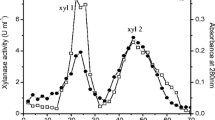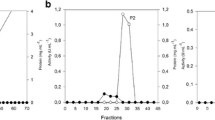Abstract
Melanocarpus albomyces, a thermophilic fungus isolated from compost by enrichment culture in a liquid medium containing sugarcane bagasse, produced cellulase-free xylanase in culture medium. The fungus was unusual in that xylanase activity was inducible not only by hemicellulosic material but also by the monomeric pentosan unit of xylan but not by glucose. Concentration of bagasse-grown culture filtrate protein followed by size-exclusion and anion-exchange chromatography separated four xylanase activities. Under identical conditions of protein purification, xylanase I was absent in the xylose-grown culture filtrate. Two xylanase activities, a minor xylanase IA and a major xylanase IIIA, were purified to apparent homogeneity from bagasse-grown cultures. Both xylanases were specific forβ-1,4 xylose-rich polymer, optimally active, respectively, at pH 6.6 and 5.6, and at 65°C. The xylanases were stable between pH 5 to 10 at 50°C for 24 h. Xylanases released xylobiose, xylotriose and higher oligomers from xylans from different sources. Xylanase IA had a Mr of 38 kDa and contained 7% carbohydrate whereas xylanase IIIA had a Mr of 24 kDa and no detectable carbohydrate. The Km for larchwood xylan (mg ml−1) and Vmax (μmol xylose min−1 mg−1 protein) of xylanase IA were 0.33 and 311, and of xylanase IIIA 1.69 and 500, respectively. Xylanases IA, II and IIIA showed no synergism in the hydrolysis of larchwood glucuronoxylan or oat spelt and sugarcane bagasse arabinoxylans. They had different reactivity on untreated and delignified bagasse. The xylanases were more reactive than cellulase on delignified bagasse. Simultaneous treatment of delignified bagasse by xylanase and cellulase released more sugar than individual enzyme treatments. By contrast, the primary cell walls of a plant, particularly from the region of elongation, were more susceptible to the action of cellulase than xylanase. The effects of xylanase and cellulase on plant cell walls were consistent with the view that hemicellulose surrounds cellulose in plant cell walls.
Similar content being viewed by others
References
Anand L, Krishnamurthy S and Vithayathil P J 1990 Purification and properties of xylanase from the thermophilic fungus,Humicola lanuginosa (Griffon and Maublanc) Bunce;Arch. Biochem. Biophys. 276 546–553
Bennett N A, Ryan J, Biely P, Vrsanska L, Kremnicky L, Macris B J, Kekos D, Christakopoulos P, Katapodis P, Claeyssens M, Nerinckx W, Ntauma P and Bhat M K 1998 Biochemical and catalytic properties of an endoxylanase purified from the culture filtrate ofThermomyces lanuginosus ATCC 46882;Carbohydr. Res. 306 445–455
Bhat K M, Gaikwad J S and Maheshwari R 1993 Purification and characterization of an extracellular β-glucosidase from the thermophilic fungusSpomtrichum thennophile and its influence on cellulase activity;J. Gen. Microbiol. 139 2825–2832
Cesar T and Mrša V 1996 Purification and properties of the xylanase produced byThermomyces lanuginosus;Enzyme Microb. Technol. 19 289–296
de Almeida E M, de Lourdes M, Polizeli T M, Terenzi H F and Jorge J A 1995 Purification and biochemical characterization of β-xylosidase fromHumicola grisea var.thermoidea;FEMS Microbiol. Lett. 130 171–176
Dekker R F H 1983 Bioconversion of hemicellulose: Aspects of hemicellulase production byTrichoderma reesei QM9414 and enzymic saccharification of hemicellulose;Biotechnol. Bioeng. 25 1127–1146
Dekker R F H and Richards G N 1975 Purification, properties, and mode of action of hemicellulase II produced byCeratocystis paradoxa;Carbohydr. Res. 42 107–123
Dubois M, Gilles K A, Hamilton J K, Rebers P A and Smith F 1956 Colorimetric method for determination of sugars and related substances;Anal. Chem. 28 350–356
Düsterhöft E-M, Linssen V A J M, Voragen A G J and Beldman G 1997 Purification, characterization, and properties of two xylanases fromHumicola insolens;Enzyme Microb. Technol. 20 437–445
Ganju R K, Vithayathil P J and Murthy S K 1989 Purification and characterization of two xylanase fromChaetomium thermophile var.coprophile;Can. J. Microbiol. 35 836–842
Gilbert M, Yaguchi M, Watson D C, Wong K K Y, Breuil C and Saddler J N 1993 A comparison of two xylanases from the thermophilic fungiThielavia terrestris andThermoascus crustaceus;Appl. Microbiol. Technol. 40 508–514
Gomes J, Gomes I, Kreiner W, Eslerbauer H, Sinner M and Steiner W 1993 Production of high level of cellulase-free and thermostable xylanase by a wild strain ofThermomyces lanuginosus using beechwood xylan;J. Biotechnol. 30 283–297
Khandke K M, Vithayathil P J and Murthy S K 1989 Purification of xylanase, β-glucosidase, endocellulase and exocellulase from a thermophilic fungusThermoascus aurantiacus;Arch. Biochem. Biophys. 274 491–500
Kitpreechavanich V, Hayashi M and Nagai S 1984 Purification and properties of endo-1,4-β-xylanase fromHumicola lanuginosa;J. Ferment. Technol. 5 415–420
Krishnamurthy S 1989Purification and properties of xylanase and β-glucosidase elaborated by the thermophilic fungus Paecilomyces varioti Bainier, Ph.D. Thesis, Indian Institute of Science, Bangalore
Lowry O H, Rosebrough N J, Farr A L and Rondall R J 1951 Protein measurement with the Folin phenol reagent;J. Biol. Chem. 193 265–275
Maheshwari R and Kamalam P T 1985 Isolation and culture of a thermophilic fungus,Melanocarpus albomyces, and factors influencing the production and activity of xylanase;J. Gen. Microbiol. 131 3017–3027
McNeil M, Darvill A G, Fry S C and Albersheim P 1984 Structure and function of the primary cell walls of plants;Annu. Rev. Biochem. 53 625–663
Messner R, Gruber G and Kubicek C P 1988 Differential regulation of synthesis of multiple forms of specific endo-glucanases byTrichoderma reesei QM 9414;J. Bacteriol. 32 277–352
Monti R, Terenzi H F and Jorge J A 1991 Purification and properties of an extracellular xylanase from the thermophilic fungusHumicola grisea var.thermoidea;Can. J. Microbiol. 37 675–681
Paturau J M 1982By-products of the cane sugar industry: An introduction to their industrial utilization (Amsterdam: Elsevier)
Purkarthofer H, Sinner M and Steiner W 1993 Cellulase-free xylanase fromThermomyces lanuginosus: Optimization of production in submerged and solid-state culture;Enzyme Microb. Technol. 15 677–682
Somogyi M 1952 Notes on sugar determination;J. Biol. Chem. 195 19–23
Takenishi S and Tsujisaka Y 1975 On the modes of action of three xylanases produced by a strain ofAspergillus niger van Tieghem;Agric. Biol. Chem. 39 2315–2323
Tan L U L, Mayers P and Saddler J N 1987 Purification and characterization of a thermostable xylanase from a thermophilic fungusThermoascus aurantiacus;Can. J. Microbiol. 33 689–692
Trevelyan W E, Procter D P and Harrison J S 1950 Detection of sugars on paper chromatograms;Nature (London) 166 444–445
Tuohy M G, Puls J, Claeyssens M, Vrsanska M and Coughlan M P 1993 The xylan-degrading enzyme system ofTalaromyces emersonii: novel enzymes with activity against aryl β-D-xylosides and unsubstituted xylans;Biochem. J. 290 515–523
Veluthambi K, Mahadevan S and Maheshwari R 1981 Trehalose toxicity inCuscuta reflexa. Correlation with low trehalase activity;Plant Physiol. 68 1369–1374
Winzler R J 1955 Determination of serum glycoproteins;Methods Biochem. Analysis 2 279–304
Wong K K Y, Tan L U L and Saddler J N 1988 Multiplicity of β-1,4-xylanase in microorganisms: Functions and applications;Microbiol. Rev. 52 305–317
Wong K K Y, Tan L U L, Saddler J N and Yaguchi M 1986 Purification of a third distinct xylanase from the xylanolytic system ofTrichoderma harzianum;Can. J. Microbiol. 32 570–576
Wu S C, Kaufmann S, Darvill A G and Albersheim P 1995 Purification, cloning and characterization of two xylanases fromMagnaporthe grisea, the rice blast fungus;Mol. Plant Microbe Interact. 8 506–514
Yoshioka H, Nagato N, Chavanich S, Nilubol N and Hayashida S 1981 Purification and properties of thermostable xylanase fromTalaromyces byssochlamydoides YH-50;Agric. Biol. Chem. 45 2425–2432
Yu E K C, Tan L U L, Chan M K-H, Deschatelets L and Saddler J N 1987 Production of thermostable xylanase by a thermophilic fungus,Thermoascus aurantiacus;Enzyme Microb. Technol. 9 16–24
Author information
Authors and Affiliations
Corresponding author
Rights and permissions
About this article
Cite this article
Prabhu, K.A., Maheshwari, R. Biochemical properties of xylanases from a thermophilic fungus,Melanocarpus albomyces, and their action on plant cell walls. J. Biosci. 24, 461–470 (1999). https://doi.org/10.1007/BF02942657
Received:
Accepted:
Published:
Issue Date:
DOI: https://doi.org/10.1007/BF02942657




